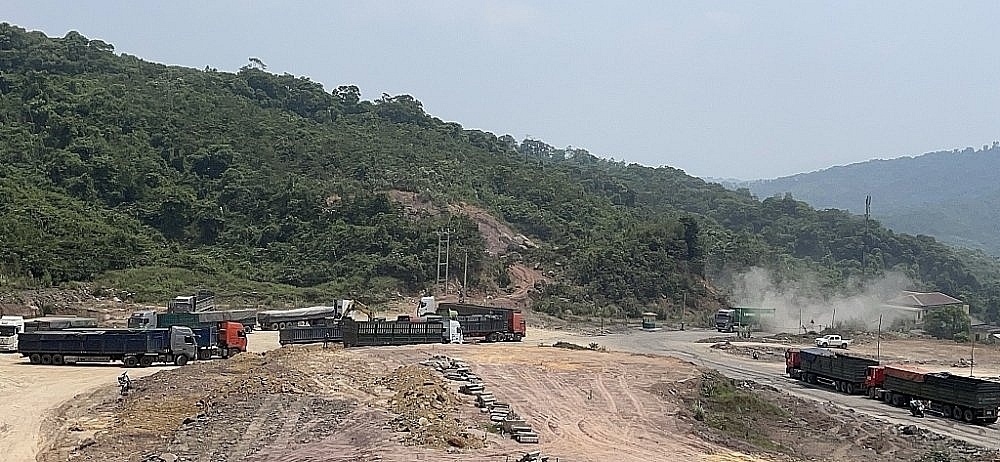 |
| The coal imports across La Lay International Border Gate in 2023. Photo: La Lay Border Gate Customs Branch. |
Building project on construction of conveyor belt to transport imported coal
La Lay International Border Gate – Quang Tri province is one of the border gates in the Vietnam – Laos border with many advantages in terms of geographical location and market, located on National Highway 15D connecting Dakrong district and Quang Tri province and Salavan Province-Laos, and adjacent to four Southern Lao provinces (including Salavan, Sekong, Champasack, Attpeau) and UBon province – the socio-economic center of the Northeast region of Thailand.
La Lay International Border Gate is also a quick and convenient connection area with key seaports of the Central region such as Da Nang, Chan May (Thua Thien Hue), My Thuy port (Quang Tri), forming the shortest economic corridor (named Para-EWEC) in parallel to the East-West Economic Corridor (EWEC), and the end area is National Highway 9, Quang Tri. Currently, the flow of goods across the two corridors is very large, especially the Para-EWEC corridor, requiring to optimize logistics processes to serve the development of freight transport and the construction of My Thuy port.
From 2022, businesses have promoted coal imports from Ka Lum mine, Laos to Vietnam across La Lay International Border Gate (about 500 thousand tons, contributing over VND100 billion to the budget).
In 2023, six enterprises carried out coal import procedures at La Lay Border Gate Customs Branch, with an output of over 2.15 million tons (an increase of more than 339% compared to the total volume of imported coal in 2022) with a turnover of over US$175 million (reaching 156% of the total import and export turnover of the whole year 2022) and the tax revenue of over VND484 billion. There are 200 vehicles transporting coal on average per day and suddenly up to 400-500 vehicles per day.
In 2024, it is expected that 22.6 million tons of coal will be exploited, 19 million tons will be exported and 11 million tons will be imported into the Vietnamese market across La Lay International Border Gate. Meanwhile, about 2-3 million tons of coal are imported on average per year across La Lay International Border Gate, which cannot meet the import demand from coal mines in Laos.
Therefore, Nam Tien Co., Ltd. and Phonesack Group have researched and proposed solutions to build a closed coal conveyor project from Laos to Vietnam with investment from the company to increase the flow of imported coal across La Lay International Border Gate.
The project put into operation will solve infrastructure difficulties at the border gate, National Highway 15D connecting to the border gate, reduce pressure on traffic infrastructure, and reduce environmental pollution compared to transporting coal by car, especially it will increase the estimated output of imported coal by 15-20 million tons/year, 10 times more than transported by normal mean of transport.
Setting out customs control requirements
Based on current regulations, the Customs is required to control for the imported coal transported by conveyor belt which must be gone through customs procedures, inspection, supervision, and to prevent smuggling and illegal transportation across the border and combat drugs.
Accordingly, Quang Tri Customs Department proposes solutions to build and complete customs procedures for imported coal transported by conveyor system across La Lay International Border Gate, and solutions on arrangement of human resource and technical infrastructure and equipment for surveillance cameras, electronic scales, and database storage systems.
Firstly, for places for gathering goods in Vietnam, the operator must meet conditions to be recognized as the place for gathering imports and exports for customs supervision and inspection at the border gate by the General Department of Vietnam Customs, especially complying with regulations in Article 36 of Decree No. 68/2016 /ND-CP dated July 1, 2016 of the Government regulating conditions for duty-free goods business, warehouses, customs checkpoint (amended and supplemented in Decree No. 67/2020/ND-CP dated June 15, 2020).
Specifically, places for gathering exports, imports for inspection and supervision in border areas should be situated within border-gate economic zones or inland checkpoint areas. If situated outside the border-gate economic zone, distance from the checkpoint area should not exceed 10 km.
The minimum area of the place for gathering imports and exports in border areas at the international border gate and major border gate should be 5,000 m2. The minimum area of the place for gathering imports and exports in the border area in other areas should be 3,000 m2.
The place should be fenced off from surrounding areas meeting requirements for regular supervision of customs agencies; should have software meeting requirements for storing and exporting online data to the Customs authorities about the name of goods, quantity, status of goods, and the time when goods are brought in, taken out, and stored in the place under the bill of lading/customs declaration for management under the Automated goods management and supervision system; have a camera system that is directly connected to customs agencies, capable of monitoring all positions in the place and working round-the-clock, and capable of storing data for at least 6 months.
Secondly, in terms of procedures, the building customs procedures for coal imports using a cross-border closed conveyor system must comply with legal regulations and makes use of the advantages on design and technology of the conveyor system.
The procedures for receiving declarations, performing inspection and supervision to must comply with current regulations for imported goods in terms of product names, quality specifications, and product codes, especially in case where the Customs conducts physical inspection of goods (red channel declaration); ensure customs control of imported coal weight by conveyor system.
Based on the operation of coal conveyors and technological systems of screening, electronic scales, surveillance cameras, ensuring customs control, preventing smuggling and taking advantage of coal conveyors for illegal transportation of goods across borders.
